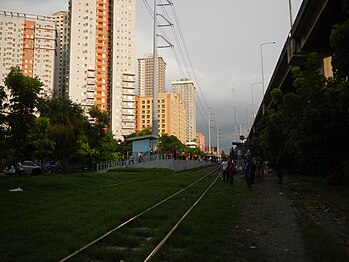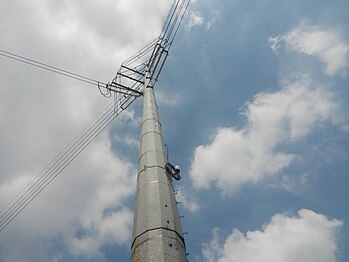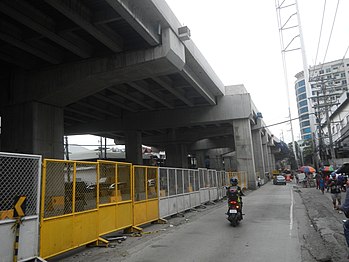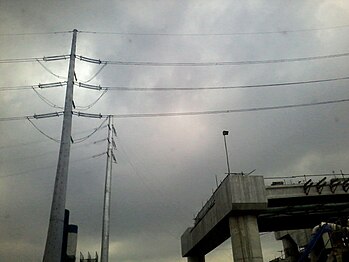Sucat–Paco–Araneta–Balintawak Transmission Line
This article has multiple issues. Please help improve it or discuss these issues on the talk page. (Learn how and when to remove these messages)
|
| Sucat–Paco–Araneta–Balintawak Transmission Line (The 2nd Tallest Transmission Line) | |
|---|---|
 A segment of the transmission line along Tomas Claudio Street/PNR in Pandacan, Manila, with the lattice tower 154 at the foreground. | |
| Location | |
| Country | Philippines |
| Province | Metro Manila |
| Coordinates | 14°26′40″N 121°3′9″E / 14.44444°N 121.05250°E 14°34′50″N 120°59′54″E / 14.58056°N 120.99833°E 14°37′6″N 121°0′56″E / 14.61833°N 121.01556°E 14°39′38″N 121°0′44″E / 14.66056°N 121.01222°E |
| From | Sucat Substation |
| Passes through | Araneta Substation Pasig River Meralco Paco Substation Magallanes Interchange |
| To | Balintawak Substation |
| Ownership information | |
| Owner | see Ownership, operations, and maintenance information |
| Operator | see Ownership, operations, and maintenance information |
| Construction information | |
| Construction started | 1996 |
| Commissioned | July 2000 |
| Technical information | |
| Type | Overhead transmission line |
| Type of current | HVAC |
| Total length | 34 km (21 mi) |
| No. of transmission towers | 246 (219 steel poles, 26 lattice towers, and 1 portal tower) |
| AC voltage | 230 kV |
| No. of poles | 219 |
| No. of circuits | 1 |
The Sucat–Paco–Araneta–Balintawak Transmission Line (abbreviated as SA,[a] 8LI1QUE-DIM,[b] 8LI1DIM-MNA,[c] 8LI1MNA-MUN,[d] SPABTL) also known as Muntinlupa–Manila–Doña Imelda–Quezon Transmission Line, and formerly known as Sucat–Araneta–Balintawak Transmission Line from July 2000 to October 2012, is a 230,000 volt, single-circuit, three-part transmission line in Metro Manila, Philippines that connects Sucat and Balintawak substations of National Grid Corporation of the Philippines (NGCP), with line segment termination at NGCP Araneta substation in Quezon City and Manila Electric Company (Meralco) Paco substation in Paco, Manila.
History
[edit]The Sucat–Paco–Araneta–Balintawak Transmission Line began construction in 1996 and went into service in July 2000 which took four years to complete because there is a right of way (ROW) or alignment constraints.[1][2] The line was constructed to increase the transmission output in the urban grid in Metro Manila to cover the increasing demand for electricity and a contribution was to be made to ensuring a continuous supply of electricity and to the macroeconomic objectives of growth and employment, and to address the Luzon power crisis from 1991 to 1993. It is one of the shortest transmission lines in the Philippines with its 34 kilometer span. The transmission line has four substations to connect but the ROW needs to be flexible which is the reason why the line uses the Skyway Stage 3 ROW. The electrical current heads south because the Hermosa–Duhat–Balintawak transmission line connects to Balintawak substation making the power line third of five lines forming the transmission network from Bataan Combined Cycle Power Plant (BCCPP) in Limay, Bataan to Calaca Power Plant in Calaca, Batangas and six to Mak–Ban Geothermal Power Plant in Santo Tomas also in Batangas and Bay in Laguna, and its frequency is 60.14 Hz (every transmission line in Philippines have 60 hertz). There are no loads measured but the information, was not publicly available.
With the construction of the Skyway Stage 3, several steel poles are being replaced by newer ones specifically those along the Araneta segment and also added new poles on certain portions of the line. The newer steel poles were made of porcelain discs (15) and 3 horizontal pole-mounted porcelain insulator. Since the construction of Skyway Stage 3, the newer design is flag design with the deadend insulators (made of polymer/porcelain)
As of 2016, the base of the transmission line segment of Sucat–Paco, Paco–Araneta, and Araneta–Balintawak segment have a large and tall circular pile with the National Grid Corporation of the Philippines (NGCP) new reflective reference tag (Araneta–Balintawak) and NAPOCOR/NPC steel pole and lattice tower numbers with NGCP's reference tags since 2015 on the Sucat–Paco and Araneta–Balintawak segments.
Route description
[edit]The Sucat–Paco–Araneta–Balintawak Transmission Line passes through the cities of Muntinlupa, Taguig, Makati, Manila, and Quezon City. The Sucat–Paco and Paco–Araneta segments are under NGCP's South Luzon Operations and Maintenance (SLOM) District 1 (South Western Tagalog) while the Araneta–Balintawak segment is under North Luzon Operations and Maintenance (NLOM) District 7 (National Capital Region).[3]
Sucat–Paco
[edit]The transmission line starts at Sucat Substation where it parallels Manuel L. Quezon Avenue and Laguna Lake Highway before it turns left. It then passes to Diego Silang Village and parallels with Carlos P. Garcia Avenue. It goes to the left again, passing through Manila American Cemetery and Bonifacio Heights before paralleling to South Luzon Expressway (SLEx) from Maricaban Creek to Magallanes Interchange and Osmeña Highway from Magallanes Interchange to Quirino Avenue. At Magallanes Interchange, it crosses to Epifanio delos Santos Avenue (EDSA). It continues on a straight route and after crossing Gil Puyat Avenue are 7 new steel poles that were used for the relocation of the line due to the construction of Skyway Stage 3. It crosses to San Andres Bukid and Paco. Near Paco Substation, the two broader Meralco transmission steel poles and one belonging to Sucat–Paco–Araneta–Balintawak line itself anchoring it before entering Paco Substation. The cut-in connection to Meralco Paco substation is located in this district, where the line's Sucat–Paco section ends.
Paco–Araneta
[edit]The line parallels to Tomas Claudio Street (or Paco–Santa Mesa Road), PNR Metro Commuter railroad and Magsaysay Boulevard, turns left to Gregorio Araneta Avenue and run parallel with the said avenue and Skyway Stage 3, and the line's Paco–Araneta section ends at Araneta Substation.
Araneta–Balintawak
[edit]The line continues paralleling Araneta Avenue and Skyway Stage 3 until it passes to Valentin Ventura Street, Tuktukan Street, and Kaingin Road before it crosses to EDSA. It turns left and after a few meters is the transmission line's terminus which is Balintawak Substation.
Technical description
[edit]The transmission line consists of 219 steel poles (53 on the Balintawak–Araneta segment (1–53) and 167 on the Araneta–Paco and Paco–Sucat segments (1–8, 30-149, 150A, 150B, and 155–185)), 26 lattice towers (9-29, 150, and 151–154), and 1 portal tower located between steel poles 49 and 50 ((8LI1MNA-MUN)97) totaling to 246 transmission structures. Steel poles have flag tower design (suspension and anchor variants), while lattice towers have incomplete tower design. Portal towers are used on portions of the line where it intersects with another power line. It has a length of 34 kilometers (21 mi) and is a single-circuit, double-bundle power line.
The highest elevation segment are the Paco-Araneta and Araneta-Balintawak segments, utilizing the Skyway Stage 3 and steel poles are 60-70m tall and they use anchor flag design poles. The segments are half Chinese design (most of the steel poles imported from China, and owned by TransCo and operated and maintained by NGCP for existing segments and poles while relocated portions and their poles are owned, operated and maintained by NGCP).
From July 2000 until the completion of the line's cut-in connection to Manila Electric Company (Meralco) Paco Substation in October 2012, it was a two-part power line. Due to the construction of the line's cut-in connection to Meralco Paco Substation, two new steel poles were added between poles 143 and 144 of the Sucat–Araneta segment of the line. This cut-in connection to the said substation also made the transmission line from being a two-part to three-part power line.
In 2018, a portal tower located between steel poles 53 and 54 ((8LI1MNA-MUN)92) was removed and retired to give way for the widening of Lawton Avenue in Taguig.
The spacers are crucial part of any power transmission lines. They help to maintain bundle spacing and prevents from arcing each other, which can cause power outages. The placing of spacers was carried from the bucket truck or spacer cart (a cart is used on EHV transmission lines and UHV transmission lines and used as spacer placing). In case of Sucat-Paco-Araneta-Balintawak transmission line, the method is to using spacer cart of NAPOCOR/NPC since the line was higher and hard to reach up (later TransCo from March 1, 2003 to January 15, 2009 and NGCP since January 15, 2009). During its final stringing of conductors, the spacer placing took place. There are 6 spacer carts per line span. If there was a broken spacer (like snapping), it will replaced with the new spacer damper or springed spacer. Most portions of a transmission line use moving-joint spacers and weighed damper (spacer), used in relocated segments of the line.
The steel poles are made of galvanized steel and they have a height of 30-70m tall. It is installed on base or foundation of the steel pole (pedestal). The installation or erection and re-erection (for secondhand structures now being used with a new function or purpose and ignoring the older or original one as part of or in compliance with the plan of a particular transmission project associated with the power line whether that part of a project's plan was planned by NAPOCOR/NPC, TransCo, and NGCP) of each structures or facilities which are steel poles, lattice towers, and portal towers from pedestal or foundation to top segment can take 1–2 days, while the completion of a right-of-way (ROW) or portion of a transmission line which involves structures are all installed or placed on lands already acquired and designated where they are located on that ROW depends on the power line portion's amount of structures, length, and how long do the structures or components part of that ROW arrive or be delivered which can range from days to years. First, on a land where the steel pole will be located, the precast concrete foundation laid underground and a cement is added to create the pole's pedestal. Second, the pedestal laid ground, then backfill up some of remaining holes between the gap. Third, the poles were laid in three to six segments, the butt segment (the lowermost), mid segment which are between the butt and top segments, and the top segment. The second to the last segment to the top and the top segment are where the insulators are placed and a steel crossarm is placed for a top segment of suspension steel poles with flag design. Fourth, the insulators were attached. Steel poles of the Araneta–Balintawak segment use square piles, while the Sucat–Paco and Paco–Araneta segments have a concrete over a square pile. Poles of the relocated segments of the line, however, use circular piles.
The transmission structure types are: steel monopole (used on relocated steel poles of Araneta-Balintawak and Paco-Araneta segments along Araneta Avenue, and on poles with irregular design), normal steel pole, lattice tower, and portal tower (located near Lawton Avenue). The name of these structures are: Ike1 (tall anchor steel monopole, used on Araneta Avenue and Skyway Stage 3), Ike2 (flag anchor steel pole), Cabadbaran1 (flag suspension steel pole), Cabadbaran2 (flag suspension steel pole with custom braced line post insulators attachment to conductor, it is used on Paco–Araneta segment), Gabbie (flag anchor steel pole with crossarms also used on Paco–Araneta segment similar to Ike1 but having narrower steel crossarm to support the overhead ground wire (OHGW) and uses normal steel pole), and PTVR (anchor irregular design steel monopole). Ike1, Cabadbaran2, and Gabbie were introduced by NGCP due to the construction of Skyway Stage 3.
Storage space for structures retired from original use and ownership
[edit]The National Power Corporation (NAPOCOR/NPC)-era transmission structures that were retired from original use and ownership because of various projects made by National Grid Corporation of the Philippines (NGCP) on the line were stored on various substations for those unused for a while. Most people know that the unused retired structures are stored in a structure's graveyard but it is not. They are stored in various substations for future other uses with their new ownership.
| Segment | Current | Volts | Heading |
|---|---|---|---|
| Sucat–Paco | not measured | 230,000 | South |
| Paco–Araneta | |||
| Araneta–Balintawak | |||
| Relocated and added steel poles segments due to construction of Skyway Stage 3 and NLEX Connector |
| Bundle type and segment | Spacers | Amps | Broken spacers |
|---|---|---|---|
| Sucat–Paco–Araneta–Balintawak (other segments) | 500 + | not measured | 0 |
| Relocated and added steel poles segments due to construction of Skyway Stage 3 and NLEX Connector) | 300 + | not measured | 0 |
| Segment | Number of structures | Length |
|---|---|---|
| Araneta–Balintawak | 53 steel poles | 5.67 km |
| Paco–Araneta | 44 (39 steel poles, 5 lattice towers) | 5.92 km |
| Sucat–Paco | 149 (128 steel poles, 21 lattice towers) | 22.24 km |
| Type of steel pole or lattice tower | Height | Weight | Insulator |
|---|---|---|---|
| Suspension steel pole (flag) | 30-70m tall | 7+ tons | 3 braced line post insulators made of 17 porcelain discs facing in one direction and forming the pole a flag shape, and a steel crossarm used to support the overhead ground wire (OHGW) at the steel pole's top segment. Some newer suspension steel poles can have polymer composite dead-end insulator. |
| Anchor steel pole (flag and irregular) | Horizontal dead-end insulators made of 17-22 porcelain discs with 3 horizontal pole-mounted porcelain insulator at the center. When viewed sidewards for the flag variant of the anchor steel pole, the horizontal pole-mounted porcelain insulators resemble the letter "E" while its front side looks like a three-leveled lowercase letter "T" or a cross. Some newer anchor steel poles can have polymer composite dead-end insulator. Irregular variant has 3 horizontal dead-end insulators on a steel crossarm and another 3 arranged in a vertical pattern, has vertical insulator mounted on one side of a crossarm, at the center are 1-2 insulators, and on the pole's top segment is another steel crossarm used to support the overhead ground wire (OHGW) where it is used near the Balintawak and Araneta substations. Newer anchor poles with flag design have 3 horizontal made of 22 porcelain discs and vertical insulators with 21 discs mounted on steel crossarms, with a crossarm at the top segment to support the OHGW. | ||
| Suspension lattice towers | 70m | no calculation | 3 double-bundle vertical suspension insulators consisting of 34 porcelain discs. |
| Anchor lattice towers | 3 dead-end horizontal insulators made with 15 porcelain discs and 6 vertical porcelain insulator. | ||
| Portal towers | 10m | Same as anchor lattice towers. |
Ownership, operations, and maintenance information
[edit]The transmission line was originally operated, maintained, and owned by the government-owned National Power Corporation (NAPOCOR/NPC) from July 2000 to March 1, 2003. Operations, maintenance, and ownership of the line then transferred to another government corporation National Transmission Corporation (TransCo) on March 1, 2003 where it operated and maintained the line until January 15, 2009. The line's operations and maintenance was transferred to privately-owned National Grid Corporation of the Philippines (NGCP) on January 15, 2009 where it now operates and maintains the power line since then.
As a result of the turnover from TransCo to NGCP, and Republic Act (RA) 9511 and concession agreement between both parties which authorized the latter to exercise the right of eminent domain necessary for the construction, expansion, and efficient maintenance and operation of the transmission system and grid and the efficient operation and maintenance of the subtransmission systems which have not yet been disposed by TransCo where NGCP acts as the temporary owner of these assets and facilities and they will be transferred to TransCo once the 50-year NGCP concession period ends on December 1, 2058, lands where the transmission structures stand and their pedestals or foundations and right-of-way or portions of a power line acquired and designated, and facilities built or placed from January 15, 2009 (new steel poles built due to the construction of Skyway Stage 3) are operated, maintained, and owned by NGCP, while those that were placed or built, acquired, and designated from July 2000 to January 14, 2009 are owned by TransCo and operated and maintained by NGCP, as one mandate of the former is to handle all existing cases, including right-of-way and claims which accrued prior to the transfer of power grid operations and maintenance to the latter on January 15, 2009. Below is the table showing the ownership information on each lands where the structures and their respective foundations and pedestals stand, and right-of-way.
| Owner | Number of lands and structures owned | Number of right-of-way or portions owned | Length | Percentage (by number of lands and structures) | Percentage (by number of right-of-way or portions) | Percentage (by length) |
|---|---|---|---|---|---|---|
| National Transmission Corporation (TransCo) | 196 (169 steel poles, 26 lattice towers, 1 portal tower) | 10 | 28.29 km | 79.67% | 55.56% | 83.21% |
| National Grid Corporation of the Philippines (NGCP; owned, operated, and maintained) | 50 steel poles | 8 | 5.94 km | 20.33% | 44.44% | 17.47% |
Health controversy
[edit]The SLEx (Makati) – Bonifacio Heights (Taguig) segment of Sucat–Paco–Araneta–Balintawak Transmission Line was criticized by the residents living along the Tamarind Road in Dasmariñas Village, Makati, who claimed the transmission line pose health risks. The said segment is located within 10 meters of Tamarind Road in the said village. The residents, led by Atty. Eduardo F. Hernandez, blamed the electromagnetic fields (EMF) emanated by the 230-kV power lines for such health issues as cancer, leukemia, and miscarriage. They also took note of no consultation with regards to the construction of the transmission line.[1]
A case was filed in Makati Regional and Metropolitan Trial Court (Makati RTC) in 2000, but was raised to the Supreme Court after failed negotiations.[4] Responding to the petition filed by the residents, the Supreme Court ruled in 2006 that the safety issue of the lines was "evidentiary in nature," although they took note of the potential health risks due to EMF radiation exposure with regards to the scientific studies. The Court also added that long-term human safety should be of paramount importance as opposed to the presumption of economic benefits.[5] Citing the said ruling, the Makati RTC in October 2008 obliged the National Transmission Corporation (TransCo) to "de-energize" the Sucat–Paco–Araneta–Balintawak Transmission Line.[6]
TransCo vice president for operations Carlito Claudio warned in November 2008 that complete retirement of the transmission line could trigger "hours-long rotating blackouts, just like during the power crisis in the 1990s," that might adversely impact the country's leading economic hubs of Makati and Ortigas, and added the unfeasibility of building an alternate underground cable line that would cost ₱1 billion. Former TransCo president Alan Ortiz noted the transmission line as a crucial line, and said claims of electromagnetic radiation associated with high-voltage transmission lines like this "have yet to be 100-percent scientifically established."[7] TransCo submitted a motion to the Supreme Court asking that they be granted until January 31, 2009 to carry out activities and coordination works in alleviating the impact of the impending shutdown, but was refused and instead supported the Makati RTC's decision in shutting the transmission line down.[4]
The transmission towers stand on National Power Corporation (NAPOCOR/NPC) and National Transmission Corporation (TransCo) right-of-ways need to be reheighted to address a controversy since 2008.
In its February 5, 2013 order, the Makati RTC approved the request of the petitioners, referring the case back to another branch following the failure of the judicial dispute resolution.[citation needed] The case is still pending at its pre-trial stage.[8]
Gallery
[edit]-
The transmission line near Arnaiz Avenue in Makati
-
Lattice towers 150 and 151, and new steel poles 150A and 150B (of anchor or flag design) along the Tomas Claudio Street/Skyway Stage 3 segment
-
Steel pole 163 located along Magsaysay Boulevard, Manila. Note that the lowest insulator on the left in which it connects to a support steel pole instead of directly connecting to pole 162 like the rest of its insulators.
-
Steel pole 13 (of suspension or flag design, in the foreground) and 14 (of anchor or flag design, in the background) of the transmission line along the east side of the Gregorio Araneta Avenue
-
Replacement pole for the pole 28 along the west side of the Gregorio Araneta Avenue
-
Steel pole 49 anchoring the line to a portal tower, located along Upper McKinley Road, Bonifacio Global City, Taguig.
-
Poles 118 (foreground) and 119 (behind it) of the transmission line, with anchor designs, beside PNR and SLEx. Also seen is pole 120, having replaced an older structure to give way to the Skyway Stage 3 project.
-
The transmission line along EDSA–Roosevelt area
-
Rerouting of the transmission line segment along Quirino Avenue in Paco, using new steel pole 144, as a result of the construction of Skyway Stage 3.
Notes
[edit]- ^ Abbreviation used on the line's Sucat–Araneta segment.
- ^ NGCP abbreviation of the line's Balintawak–Araneta segment. (Introduced by NGCP and putting stickers (the yellow and black one) along Balintawak-Araneta segment, example: [8LI1QUE-DIM] 123.)
- ^ NGCP abbreviation of the line's Araneta–Paco segment.. (Introduced by NGCP and putting stickers (the yellow and black one) along Araneta-Paco segment, example: [8LI1DIM-MNA] 123.)
- ^ NGCP abbreviation of the line's Paco–Sucat segment. (Introduced by NGCP and putting stickers (the yellow and black one) along Paco-Sucat segment, example: [8LI1MNA-MUN] 123.)
References
[edit]- ^ a b "'Silent killer' at Tamarind Road". PhilStar.com. January 27, 2015. Retrieved September 21, 2019.
- ^ "Empowering Partnerships: Meralco 2009 Annual Report" (PDF). Meralco. Retrieved December 11, 2023.
- ^ "Operations - National Grid Corporation of the Philippines: Business Scope". ngcp.ph. Retrieved April 12, 2021.
- ^ a b "3-hour brownouts loom over Metro Manila, Bulacan". GMA News. November 27, 2008. Retrieved August 25, 2020.
- ^ "G.R. No. 145328". Lawphil.net. Retrieved September 21, 2019.
- ^ "Removal of power line to cut RP's competitiveness". GMA News. November 28, 2008. Retrieved August 25, 2020.
- ^ Gatdula, Donnabelle L. (November 28, 2008). "Transco warns of blackouts". Philstar.com. Retrieved April 23, 2020.
- ^ "Preliminary Information Statement for Annual Stockholders' Meeting on May 26, 2020" (PDF). PDS Group. p. 143. Retrieved January 11, 2021.
External links
[edit]- Philippines_Sucat_Balintawak_2007.pdf - 2007 evaluation by Entwicklungsbank.de









